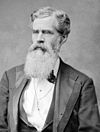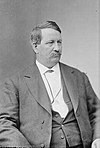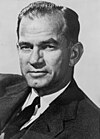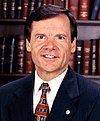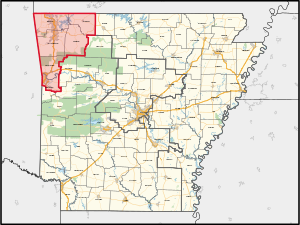
Texas's 13th congressional district is a congressional district in the U.S. state of Texas that includes most of the Texas Panhandle, parts of Texoma and northwestern parts of North Texas. The principal cities in the district are Amarillo, Gainesville and Wichita Falls. It winds across the Panhandle into the South Plains, then runs east across the Red River Valley. Covering over 40,000 square miles (100,000 km2), it is the 19th-largest district by area in the nation, the 14th-largest that does not cover an entire state, as well as the second-largest in Texas behind the 23rd congressional district. It covers more land mass than thirteen entire states. After the 2020 census was completed, the 13th district was heavily redrawn to incorporate Denton, an increasingly Democratic-leaning suburb of the Dallas-Fort Worth metroplex which had previously anchored the 26th district. With a Cook Partisan Voting Index rating of R+26, it is one of the most Republican districts in Texas.
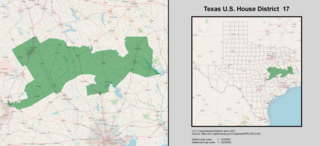
Texas's 17th congressional district of the United States House of Representatives includes a strip of Central Texas and Deep East Texas stretching from Nacogdoches to Waco and Round Rock, including former President George W. Bush's McLennan County ranch. The district is currently represented by Republican Pete Sessions.
Arizona's 1st congressional district is a congressional district located in the U.S. state of Arizona, covering northeastern Maricopa County. Before 2023, geographically, it was the eleventh-largest congressional district in the country and included much of the state outside the Phoenix and Tucson metropolitan areas. From 2013 through 2022, it also included the Navajo Nation, the Hopi reservation, and the Gila River Indian Community, with 25% of the population being Native American. At that time, the district had more Native Americans than any other congressional district in the United States. In the 2022 elections, David Schweikert was elected in the redefined district. It was one of 18 districts that would have voted for Joe Biden in the 2020 presidential election had they existed in their current configuration while being won or held by a Republican in 2022.

Kentucky's 3rd congressional district is a congressional district in the U.S. state of Kentucky. It encompasses almost all of Louisville Metro, which, since the merger of 2003, is consolidated with Jefferson County, though other incorporated cities exist within the county, such as Shively and St. Matthews. The far eastern portions of Louisville Metro are part of the 2nd congressional district.
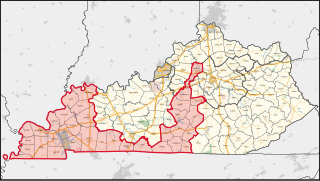
Kentucky's 1st congressional district is a congressional district in the U.S. state of Kentucky. Located in Western Kentucky, and stretching into Central Kentucky, the district takes in Henderson, Hopkinsville, Madisonville, Paducah, Murray, Danville, and Frankfort. The district is represented by Republican James Comer who won a special election to fill the seat of Rep. Ed Whitfield who resigned in September 2016. Comer also won election to the regular term to begin January 3, 2017.
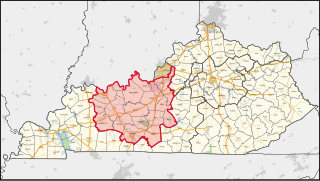
Kentucky's 2nd congressional district is a congressional district in the U.S. state of Kentucky. Located in west central Kentucky, the district includes Bowling Green, Owensboro, Elizabethtown, and a portion of eastern Louisville. The district has not seen an incumbent defeated since 1884.

Kentucky's 5th congressional district is a congressional district in the U.S. state of Kentucky. Located in the heart of Appalachia in Southeastern Kentucky, it represents much of the Eastern Kentucky Coalfield. The rural district is the second most impoverished district in the nation and, as of the 2010 U.S. census, has the highest percentage of White Americans in the nation. It contains the counties of Bell, Boyd, Breathitt, Clay, Elliot, Floyd, Harlan, Jackson, Johnson, Knott, Knox, Laurel, Lawrence, Lee, Lincoln, Leslie, Letcher, Magoffin, Martin, McCreary, Menifee, Morgan, Owsley, Perry, Pike, Pulaski, Rockcastle, Rowan, Wayne, Whitley, Wolfe, and parts of Bath, and Carter counties. Within the district are the economic leading cities of Ashland, Pikeville, Prestonsburg, Middlesboro, Hazard, Jackson, Morehead, London, and Somerset. It is the most rural district in the United States, with 76.49% of its population in rural areas. It has been represented by Republican Hal Rogers since 1981.
Arizona's 8th congressional district is a congressional district located in the U.S. state of Arizona. It includes many of the suburbs north and west of Phoenix, in Maricopa County, Arizona. The district includes several high-income retirement communities, including Sun City West.
Arizona's 6th congressional district is a congressional district located in the U.S. state of Arizona and encompasses all of Greenlee County, most of Cochise County, and parts of Pima County, Pinal County and Graham County. Most of its population resides in suburbs of Tucson, including Oro Valley, Marana, Green Valley, and Vail. The district is currently represented by Republican Juan Ciscomani. It was one of 18 districts that would have voted for Joe Biden in the 2020 presidential election had they existed in their current configuration while being won or held by a Republican in 2022.
Arizona's 4th congressional district is a congressional district located in the U.S. state of Arizona. It is represented by Democrat Greg Stanton as of the 2022 election. The district is located entirely within Maricopa County.
Arizona's 3rd congressional district is a congressional district that includes most of southern, western, and downtown Phoenix, along with a portion of Glendale. It is currently represented by Democrat Ruben Gallego.

South Carolina's 3rd congressional district is a congressional district in western South Carolina bordering both Georgia and North Carolina. It includes all of Abbeville, Anderson, Edgefield, Greenwood, Laurens, McCormick, Oconee, Pickens, and Saluda counties and portions of Greenville and Newberry counties. The district is mostly rural, but much of the economy revolves around the manufacturing centers of Anderson and Greenwood. With a Cook Partisan Voting Index rating of R+21, it is the most Republican district in South Carolina.
Wisconsin's 1st congressional district is a congressional district of the United States House of Representatives in southeastern Wisconsin, covering Kenosha County, Racine County, and most of Walworth County, as well as portions of Rock County and Milwaukee County. The district's current Representative is Republican Bryan Steil.

Florida's 2nd congressional district is a congressional district in the U.S. state of Florida. The district consists of the eastern part of the Florida Panhandle along with much of the Big Bend region along the Emerald Coast. It straddles both the Eastern and Central time zones. It is anchored in Tallahassee, the state capital, and includes Panama City. With 49% of its residents living in rural areas, it is the least urbanized district in the state, and voters are generally conservative. The district is represented by Republican Neal Dunn.

Arkansas's 1st congressional district is a U.S. congressional district in eastern Arkansas that elects a representative to the United States House of Representatives. It is currently represented by Republican Rick Crawford. With a Cook Partisan Voting Index rating of R+22, it is the most Republican district in Arkansas, a state with an all-Republican congressional delegation.

Arkansas's 2nd congressional district is a congressional district located in the central part of the U.S. state of Arkansas and includes the state capital of Little Rock, its suburbs, and surrounding areas. The district leans Republican, with a Cook Partisan Voting Index rating of R+9. However, due to the influence of heavily Democratic Little Rock, it is still considered the least Republican congressional district in Arkansas, which has an all-Republican congressional delegation.

Arkansas's 4th congressional district is a congressional district located in the southwestern portion of the U.S. state of Arkansas. Notable towns in the district include Camden, Hope, Hot Springs, Magnolia, Pine Bluff, and Texarkana.

Oklahoma's 2nd congressional district is one of five United States congressional districts in Oklahoma and covers approximately one-fourth of the state in the east. The district borders Arkansas, Kansas, Missouri, and Texas and includes a total of 24 counties. With a Cook Partisan Voting Index rating of R+29, it is the most Republican district in Oklahoma, a state with an all-Republican congressional delegation.

North Carolina's 4th congressional district is located in the central region of the state. The district includes all of Alamance County, Durham County, Granville County, Orange County, and Person County, as well as a portion of Caswell County. With a Cook Partisan Voting Index rating of D+16, it is the most Democratic district in North Carolina.
Missouri's 7th congressional district consists of Southwest Missouri. The district includes Springfield, the home of Missouri State University, the Joplin, Missouri, metropolitan area, Missouri's 5th largest, and the popular tourist destination city of Branson. Located along the borders of Kansas, Oklahoma, and Northwest Arkansas, the district occupies part of the Bible Belt with a strong socially conservative trend. George W. Bush defeated John Kerry here 67% to 32% in the 2004 election. Republican John McCain defeated Democrat Barack Obama 63.1% to 35.3% in the 2008 election. Republican and Former Massachusetts Governor Mitt Romney defeated Barack Obama 67.6% to 30.3% in the 2012 election. In the 2020 election, Republican Donald Trump defeated Democrat Joe Biden 69.91% to 28.93%. As of 2020, this district is the second most strongly Republican district in Missouri and is one of the most strongly Republican districts in the United States.





